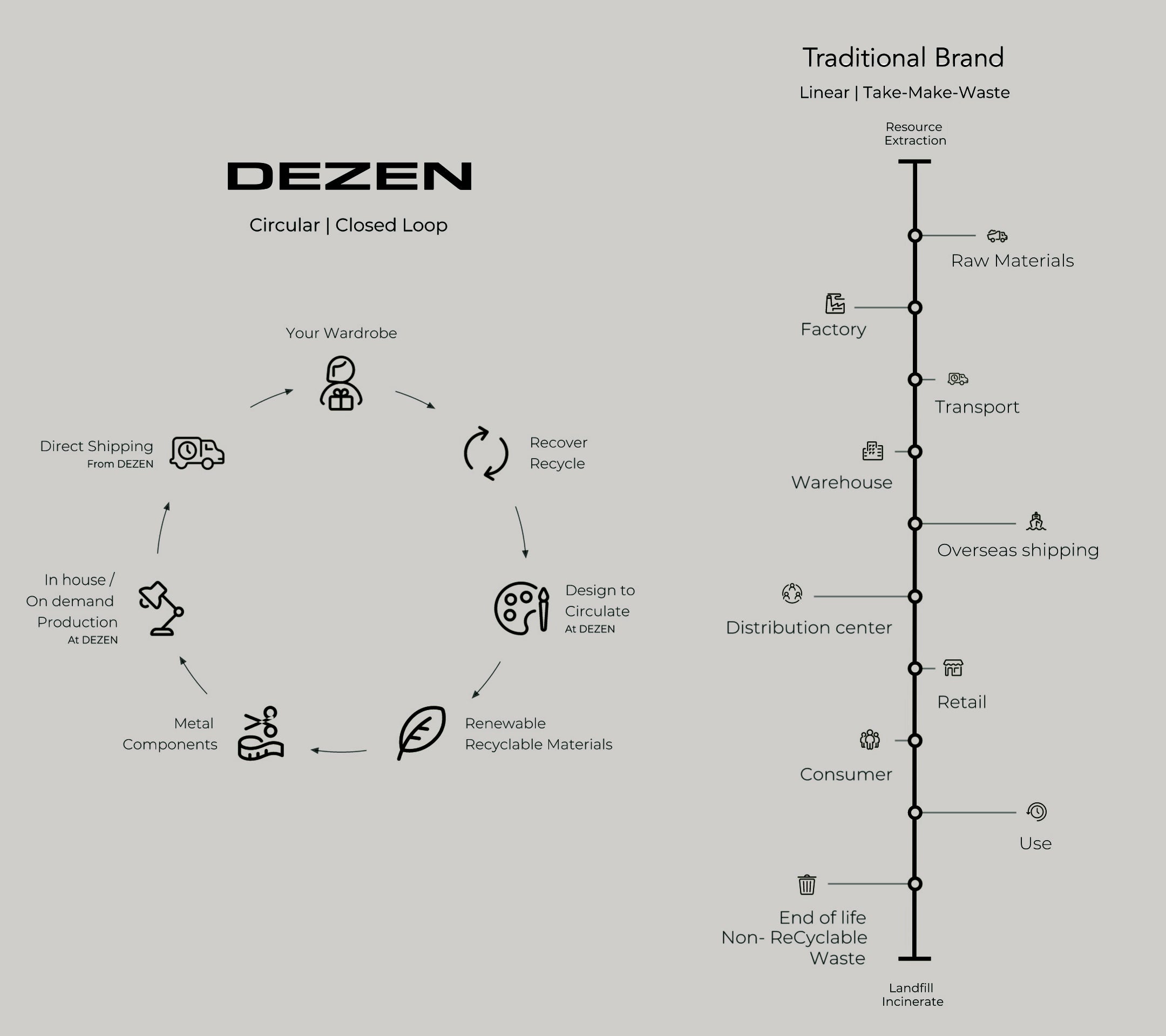Circularity
Revolutionizing how we use resources

What is Circular Fashion
"a model for an economy that is regenerative by design"
Ellen MacArthur Foundation
At DEZEN we have designed our entire process to be aligned with circular principles. From the material we use, to our production, to the end-of-life program we offer our customers, we have fully embraced circular design, creating a zero-waste process and an ethical supply chain.
When we design our accessories, we incorporate fashion trends and style using the materials that are best suited for creating the look, while also being safe for our customers and for our planet. We design the products in such a way at the end of their life we can separate the pieces into their various parts, and then redesign.
Our mission is to create beautiful pieces that respond to the fashion sense customers are looking for in a process that is respectful to the earth and the people who work with us.
The difference between a linear and a circular economy

⬤
Check out our pilot program for our customers to join and work together to close the loop.
The Circular economy vision and approach gives endless possibilities to create thriving economy. It’s a new way to design, make, and use things within planetary boundaries. By designing out waste and pollution, keeping products and materials in use, and regenerating natural systems we can reinvent everything.
if you would like to know how we incorporate the principles of the circular economy into our designs at DEZEN
MORE ON CIRCULARITY
"Circular fashion can be defined as clothes, shoes or accessories that are designed, sourced, produced and provided with the intention to be used and circulate responsibly and effectively in society for as long as possible in their most valuable form, and hereafter return safely to the biosphere when no longer of human use ."Anna Brismar
"Circular fashion is a system where our clothing and personal belongings are produced through a more considered model: where the production of an item and the end of its life are equally important."
Fashion is primarily produced in a linear system of “take, make, dispose”, with 73% of the world’s clothing eventually ending in landfills. If textile collection rates were tripled by 2030, it could be worth more than EUR 4 billion for the world economy. Unless the whole fashion industry acts now, the linear model will soon reach its physical limits. According to current forecasts, the world population will exceed 8.5 billion people by 2030, and global garment production will increase by 81%, continuing to depend on finite planetary resources. This is why current practices are putting both the industry and the planet in jeopardy, and why the pace of transformation to a circular fashion system must accelerate rapidly.Boston Consulting Group
The circular system and the linear system differ from each other in how value is created or maintained. A linear economy traditionally follows the “take-make-dispose” step-by-step plan. This means that raw materials are collected, transformed into products until we, the consumer discards them as waste. Value is created in this economic system by producing and selling as many products as possible.
A circular economy seeks to rebuild capital, whether its financial, manufactured, human, social or natural. This ensures enhanced flows of goods and services. The system diagram illustrates the continuous flow of technical and biological materials through the ‘value circle’. Closing these cycles requires much more than just recycling. It changes how value is created and preserved, how production is made more sustainable and which business models are used. According to the Ellen MacArthur Foundation the design sits prominently at the heart of the circular economy. It requires us to redesign everything: products, business models, cities, and the linear systems that have lasted for the past centuries.
The Ellen MacArthur Foundation Butterfly Diagram below was designed in order to acknowledge the need for addressing the entire life cycle of a product. Products are redesigned in a way that last longer through circular processes such as maintenance, repair, re-manufacture, recycle or biochemical feed stock, cascading, anaerobic digestion, composting. The diagram’s spine represents the linear economic model, while the rest of it illustrates the continuous flow of technical and biological materials through ‘value circles’. The smaller the cycle is, the greater the product’s value that maintains.

